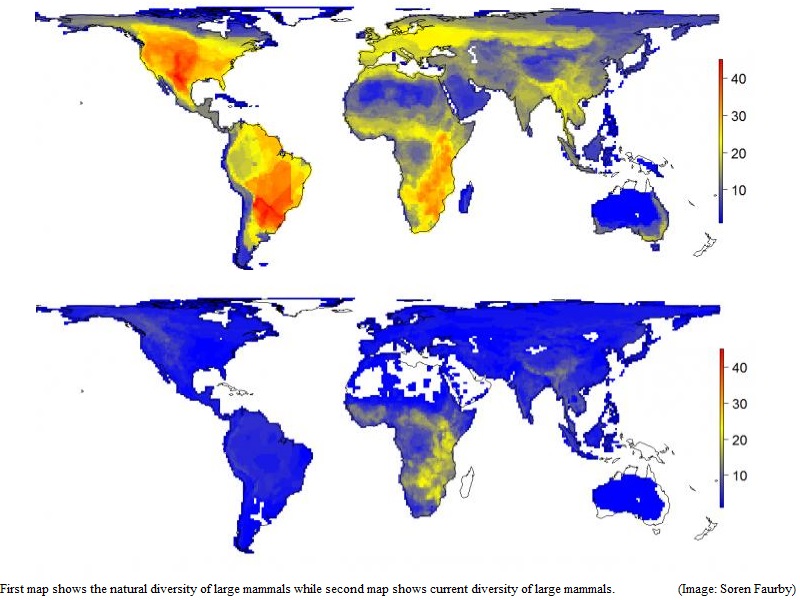- Home
- Science
- Science News
- Novel Map Reveals the World Without Humans
Novel Map Reveals the World Without Humans

In a world without humans, most of northern Europe would probably now be home to not only wolves, Eurasian elk (moose) and bears, but also animals such as elephants and rhinoceroses.
The current world map of mammal diversity by a team from Aarhus University in Denmark shows that Africa is virtually the only place with a high diversity of large mammals.
However, the world map constructed for the natural diversity of large mammals shows far greater distribution of high large-mammal diversity across most of the world, with particularly high levels in North and South America, areas that are currently relatively poor in large mammals.
"Northern Europe is far from the only place in which humans have reduced the diversity of mammals - it's a worldwide phenomenon. In most places, there's a very large deficit in mammal diversity relative to what it would naturally have been," explained professor Jens-Christian Svenning, one of the researchers behind the study.
In a previous analysis, the team has shown that the mass extinction of large mammals during the Last Ice Age and in subsequent millennia (the late-Quaternary megafauna extinction) is largely explainable from the expansion of modern man (Homo sapiens) across the world.
In this follow-up study, they investigated what the natural worldwide diversity patterns of mammals would be like in the absence of past and present human impacts.
Most safaris today take place in Africa under natural circumstances as many or even more large animals would no doubt have existed in other places.
"The reason that many safaris target Africa is not because the continent is naturally abnormally rich in species of mammals. Instead it reflects that it's one of the only places where human activities have not yet wiped out most of the large animals," informed post-doctoral Fellow Soren Faurby and the lead author on the study.
The existence of Africa's many species of mammals is thus not due to an optimal climate and environment, but rather because it is the only place where they have not yet been eradicated by humans.
Today, there is a particularly large number of mammal species in mountainous areas.
"The current high level of biodiversity in mountainous areas is partly due to the fact that the mountains have acted as a refuge for species in relation to hunting and habitat destruction, rather than being a purely natural pattern," the authors noted in a paper published in the scientific journal Diversity and Distributions.
The new study can provide an important base-line for nature restoration and conservation.
For the latest tech news and reviews, follow Gadgets 360 on X, Facebook, WhatsApp, Threads and Google News. For the latest videos on gadgets and tech, subscribe to our YouTube channel. If you want to know everything about top influencers, follow our in-house Who'sThat360 on Instagram and YouTube.
Related Stories
- Amazon Great Indian Festival 2024
- Big Billion Days 2024
- Apple Vision Pro
- Oneplus 12
- iPhone 14
- Apple iPhone 15
- OnePlus Nord CE 3 Lite 5G
- iPhone 13
- Xiaomi 14 Pro
- Oppo Find N3
- Tecno Spark Go (2023)
- Realme V30
- Best Phones Under 25000
- Samsung Galaxy S24 Series
- Cryptocurrency
- iQoo 12
- Samsung Galaxy S24 Ultra
- Giottus
- Samsung Galaxy Z Flip 5
- Apple 'Scary Fast'
- Housefull 5
- GoPro Hero 12 Black Review
- Invincible Season 2
- JioGlass
- HD Ready TV
- Laptop Under 50000
- Smartwatch Under 10000
- Latest Mobile Phones
- Compare Phones
- Nubia V70 Design
- Tecno Pop 9 4G
- Nubia Z70 Ultra
- Vivo Y300 5G
- Red Magic 10 Pro+
- Red Magic 10 Pro
- Asus ROG Phone 9
- Asus ROG Phone 9 Pro
- Asus Zenbook S 14
- MacBook Pro 16-inch (M4 Max, 2024)
- Huawei MatePad 11.5
- Acer Iconia Tab 10.36 (iM10-22)
- Nubia Watch GT
- Redmi Band 3
- Sony 65 Inches Ultra HD (4K) LED Smart TV (KD-65X74L)
- TCL 55 Inches Ultra HD (4K) LED Smart TV (55C61B)
- Sony PlayStation 5 Pro
- Sony PlayStation 5 Slim Digital Edition
- Carrier 2.0 Ton 5 Star Inverter Split AC (24K EMPERIA LXI INV)
- Lloyd 2 Ton 3 Star Inverter Split AC (GLS24I36WGVR)

















